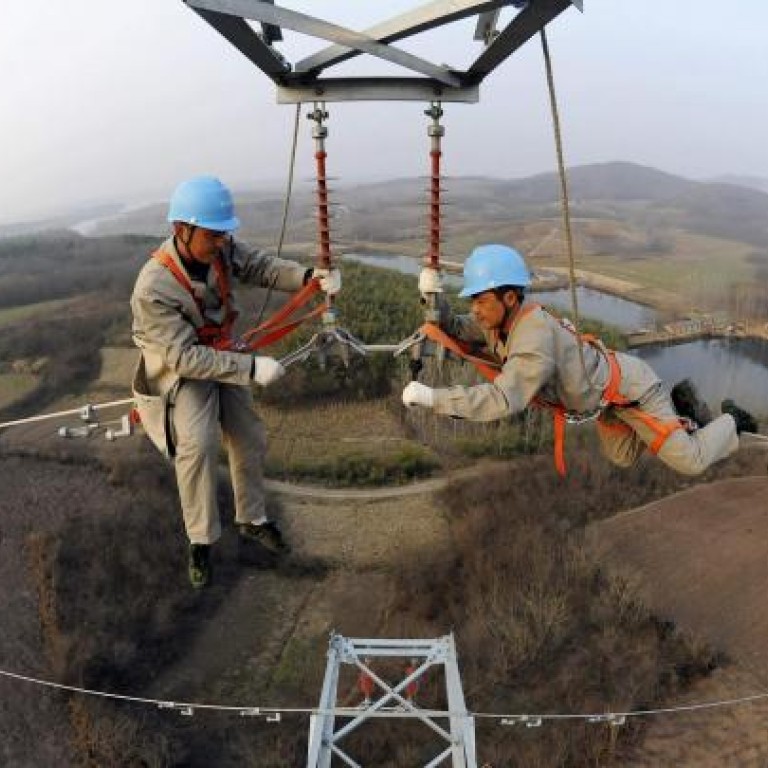
Beijing struggling to fulfil its vow to reform power pricing
Efforts to make prices dependent on demand and supply have largely failed, with the state body reluctant to relinquish control
Beijing's decade-long attempt to change its electricity pricing system, from one set by bureaucrats to one based on demand and supply, has made little headway.
The effort, first spearheaded by former Premier Zhu Rongji, has been hampered by insufficient political courage to open the market to price competition and let end-user electricity prices reflect the true cost of energy production and distribution, analysts said.
At the end of 2002, a circular on power pricing reform was approved by the State Council. It envisioned "gradually setting up a power pricing system that is commensurate with a socialist market economy", with a long-term objective to have on-grid tariffs charged by generators and end-user tariffs determined by market forces. Transmission and distribution tariffs would continue to be set by the state.
For the short-term, it wanted on-grid tariffs to reflect a "suitable level of competition" among generators, and realise a close linkage of on-grid and end-user tariffs. No time-frame was given.
As long as there is no time-table, all the talk about pricing reform is not meaningful
The purpose of reform is to increase efficiency in the entire power generation and distribution supply chain, so as to facilitate economic growth and environment protection, the circular noted. However, it added a caveat that prices must "remain largely stable" in the initial stages.
A decade after the State Council's circular, on-grid and end-user tariffs remain under National Development and Reform Commission's (NDRC) control.
In late-2004, Beijing launched a mechanism to link power and coal prices, under which power prices would be raised whenever coal prices rise by five per cent or more over six months, so that power producers would bear only 30 per cent of the higher coal costs, with the rest passed on to distributors and end-users.
But subsequent sharp surges in coal prices and Beijing's imperative to protect poor residents meant power price increases fell well behind rises in coal prices, resulting in huge losses for power generators in 2008 and 2011.
With coal prices having fallen some 25 per cent last year, the NDRC said in December it would stop meddling in coal prices this year, and would set prices so that power generators could pass on 90 per cent of the burden if coal prices rise more than 5 per cent over 12 months. It added that it would retain the right to intervene in price-setting if extraordinary market conditions result in sharp coal price rises, and by how much prices will reflect true demand and supply therefore remains to be seen.
Also in 2004, another reform was launched, albeit only in the form of trials in northeast and eastern China. Competitive bidding was introduced for the sale of a minor portion of power generators' output in these regions.
But the experiment was stopped within a year, as tight power supply saw power prices going through the roof, going against Beijing's wish for power prices to "remain largely stable".
In another trial reform in 2009, direct power trading was permitted between large industrial users and generators. Some 15 aluminium smelters nationwide were allowed to purchase electricity directly from power producers at negotiated prices, hence by-passing the distribution monopolies.
Another eight companies in Jiangsu province were allowed to join last year.
Some local governments saw this as an opportunity to help some energy-intensive industries suffering from the aftermath of the global economic crisis by letting them buy power directly from generators.
This has worried the NDRC, which in 2011 ordered local governments to cancel all such arrangements without its blessing to prevent expansion of these pollution-prone manufacturing activities.
Despite the setbacks, Beijing has continued to be reform-minded. In the 12th five-year energy industry development plan unveiled in late January for 2011-2015, Beijing reiterated its objectives to "speed up" price reform and "smooth out" conflicts in coal and power pricing. These objectives have been voiced by Premier Wen Jiabao in his annual government work reports at the National People's Congress.
Analysits are not optimistic the NDRC will relinquish control.
"As long as there is no time-table, all the talk about pricing reform is not meaningful," said Lin Boqiang, director of Xiamen University's Centre for China Energy Economics Research. "If anything, the impetus for reform has actually become weaker than a decade ago, as many profit-oriented private and foreign enterprises have been squeezed out due to the policy risks."
Pierre Lau, Citi head of Asia utilities and clean energy research, wrote in a research report that the key pre-requisites for major strides in on-grid and end-user power price reform is turning power generators into truly profit-oriented companies.
"At the moment, the performance of the state-owned or controlled generators and their management are not appraised primarily by their profits."
Despite expectations the new government, led by Xi Jinping, will carry out social and economic reforms, energy pricing remains a thorny issue given maintenance of social stability is on top of the agenda.
"One may think the new leadership will bring new hopes for reform, but we must not forget that many of the implementers in the government have not changed and their top priority of social harmony and stability has not changed," Lin said.

